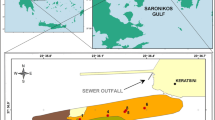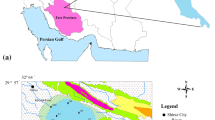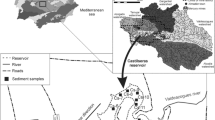Abstract
The Messolonghi lagoon complex in Western Greece receives agricultural and domestic effluents both from point and diffused sources. Surface sediments were analyzed for grain size, organic carbon, total nitrogen, total sulfur, major and minor elements, aiming at the identification of geochemical relationships between all variables. Enrichment factors and the modified degree of contamination methods were applied to assess potential heavy metal enrichment related to human activities. Sediment texture was highly variable, with muddy sediments prevailing. In the central sector of the Messolonghi lagoon, organic carbon contents were high. Principal factor analysis revealed the following main groups of variables with common geochemical behavior: (1) terrigenous aluminosilicates (2) organic matter, (3) biogenic carbonates, (4) mineral quartz-aluminosilicates, and (5) Mn-oxides. Enrichment factors estimated for V, Cr, Mn, Co, Ni, Cu, Zn, and Pb using local pre-industrial sediment showed that all metals exhibit almost natural background levels, except for Pb, which was found to be slightly elevated (legacy of leaded fuel). Estimation of contamination factors concluded in similar results, whereas the overall modified degree of contamination was at the lowest level, therefore suggesting that this transitional water body has not been affected by anthropogenic activities. The data set may be considered as a baseline for future monitoring projects according to EU policy.





Similar content being viewed by others
References
Abrahim GMS (2005) Holocene sediments of Tamaki Estuary: characterisation and impact of recent human activity on an urban estuary in Auckland, New Zealand. PhD thesis, University of Auckland, Auckland, New Zealand, p 361
Abrahim GMS, Parker RJ (2008) Assessment of heavy metal enrichment factors and the degree of contamination in marine sediments from Tamaki Estuary, Auckland, New Zealand. Environmental Monitoring Assessment. doi:10.1007/s10661-007-9678-2
Acquavita A, Predonzani S, Mattassi G, Rossin P, Tamberlich F, Falomo J, Valic I. (2010) Heavy metal contents and distribution in coastal sediments of the Gulf of Trieste (Northern Adriatic Sea, Italy). Water Air Soil Pollut. doi:10.1007/s11270-009-0284-5
Anagnostou Ch, Karageorgis A, Hatiris G, Drakopoulou P (2009) The deltaic-lagoonal systems of Acheloos and Evinos Rivers (Western Greece): evolution and changes related to anthropogenic activities and sea-level rise. Abstracts, Fourth European Conference on Coastal Lagoon Research, December 14–18, 2009, Montpellier, France, p 70
Anonymous (2001) Study of management of fishery exploitation of Greek lagoons. Project PESCA. Ministry of Agriculture of Greece, Direction of Aquaculture (in Greek)
Atkinson MJ, Smith SV (1983) C:N:P ratios of benthic marine plants. Limnol Oceanogr 28:568–574
Basset A, Sabetta L, Fonnesu A, Mouillot D, Do Chi T, Viaroli P, Giordani G, Reizopoulou S, Abbiati M, Carrada GC (2006) Typology in Mediterranean transitional waters: new challenges and perspectives. Aquat Conserv Mar Freshw Ecosyst 16:441–455
Basu A, Molinaroli E (1994) Toxic metals in Venice lagoon sediments: model, observations, and possible removal. Environ Geol 24:203–216
Bellucci LG, Frignani M, Paolucci D, Ravanelli M (2002) Distribution of heavy metals in sediments of the Venice Lagoon: the role of the industrial area. Sci Total Environ 295:35–49
Bellucci LG, Giuliani S, Mugnai C, Frignani M, Paolucci D, Albertazzi S, Ruiz Fernandez AC (2010) Anthropogenic metal delivery in sediments of Porto Marghera and Venice Lagoon (Italy). Soil Sediment Contam Int J. doi:10.1080/15320380903390562
Beltrame MO, De Marco SG, Marcovecchio JE (2009) Dissolved and particulate heavy metals distribution in coastal lagoons. A case study from Mar Chiquita Lagoon, Argentina. Estuar Coast Shelf Sci 85:45–56
Bernardello M, Secco T, Pellizzato F, Chinellato F, Sfriso A, Pavoni B (2006) The changing state of contamination in the Lagoon of Venice. Part 2: Heavy metals. Chemosphere 64(8):1334–1345
Brügmann L (1995) Metals in sediments and suspended matter of the river Elbe. Sci Total Environ 159:53–65
Calvert SE, Pedersen TF (1993) Geochemistry of recent oxic and anoxic marine sediments: implications for the geological record. Mar Geol 113:67–88
Cowie GL, Hedges JI (1992) Sources and reactivities of amino acids in a coastal marine environment. Limnol Oceanogr 37:703–729
Cutter GA, Radford-Knoery J (1991) Determination of carbon, nitrogen, sulfur and inorganic sulfur species in marine particles. In: Hurd DC, Spencer DW (eds) Marine particles: analysis and characterization American Geophysical Union, Geophysical Monograph Series 63, pp 57–63
Daesslé LW, Camacho-Ibar VF, Carriquiry JD, Ortiz-Hernández MC (2004) The geochemistry and sources of metals and phosphorus in the recent sediments from the Northern Gulf of California. Cont Shelf Res 24:2093–2106
Dassenakis M, Krasakopoulou E, Matzara B (1994) Chemical characteristics of Aetoliko Lagoon, Greece, after an ecological shock. Mar Pollut Bull 28:427–433
Dimitriou E (2007) Contribution to the study of growth and behaviour of the sea bream (Sparus aurata L.) in the Messolonghi–Etoliko lagoons. PhD thesis, University of Patras, 207 p (in Greek with English abstract)
Dimitriou E, Rogdakis Y, Leonardos J, Athanasopoulos A (1994) The quantitative and qualitative composition of fishes catch of Messolonghi–Aetoliko lagoon as index to fishing management. Fish News Int 155:82–91 (in Greek)
Donazzolo R, Orio AA, Pavoni B, Perin G (1984) Heavy metals in sediments of the Venice lagoon. Oceanol Acta 7:25–32
Duarte CM (1990) Seagrass nutrient content. Mar Ecol Prog Ser 67:201–207
Fang TH, Li JY, Feng HM, Chen HY (2009) Distribution and contamination of trace metals in surface sediments of the East China Sea. Mar Environ Res 68:178–187
Folk RL (1974) Petrology of sedimentary rocks. Hemphil, Austin
Förstner U, Wittmann GTW (1979) Metal pollution in the aquatic environment. Springer, New York
González I, Águila E, Galán E (2007) Partitioning, bioavailability and origin of heavy metals from the Nador lagoon sediments (Morocco) as a basis for their management. Environ Geol 52:1581–1593
Håkanson L (1980) Ecological risk index for aquatic pollution control, a sedimentological approach. Water Res 14:975–1001
Horowitz AJ (1991) A primer on sediment—trace element chemistry. Lewis Publishers Ltd., Chelsea
Hotos GN, Avramidou DN (1997) A one year water monitoring study of Klisova lagoon (Mesolonghi, W. Greece). GeoJournal 41:15–23
Huang W, Campredon R, Abrao JJ, Bernat M, Latouche C (1994) Variation of heavy metals in recent sediments from Piratininga lagoon (Brazil): interpretation of geochemical data with the aid of multivariate analysis. Environ Geol 23:241–247
Karageorgis AP (2007) Geochemical study of sediments from the Amvrakikos Gulf lagoon complex, Greece. Trans Waters Bull. doi:10.1285/i1825229Xv1n3p3
Karageorgis AP, Anagnostou CL, Kaberi H (2005) Geochemistry and mineralogy of the NW Aegean Sea surface sediments: implications for river runoff and anthropogenic impact. Appl Geochem. doi:10.1016/j.apgeochem.2004.07.008
Karageorgis AP, Katsanevakis S, Kaberi H (2009) Use of enrichment factors for the assessment of heavy metal contamination in the sediments of Koumoundourou Lake, Greece. Water Air Soil Pollut. doi:10.1007/s11270-009-0041-9
Katselis G, Koukou K, Dimitriou E, Koutsikopoulos C (2007) Short-term seaward fish migration in the Messolonghi–Etoliko lagoons (Western Greek coast) in relation to climatic variables and the lunar cycle. Estuar Coastal Shelf Sci. doi:10.1016/j.ecss.2007.02.010
Louda JW, Li J, Liu L, Winfree MN, Baker EW (1998) Chlorophyll-a degradation during cellular senescence and death. Org Geochem 29:1233–1251
Mahler BJ, Van Metre PC, Callender E (2006) Trends in metals in urban and reference lake sediments across the United States, 1970 to 2001. Environ Toxicol Chem. doi:10.1897/05-459R.1
Mariolakos I, Mariolakos D, Fountoulis I, Tziovara A, Champilomati A, Anagnostou Ch, Sakellariou D (2004) Shallow sampling drillings in the Acheloos delta area: preliminary results and radiocarbon dating. Abstracts, 10th International Congress of the Geological Society of Greece, 15–17 April, Thessaloniki, Greece, 496–497
Nicolaidou A, Bourgoutzani F, Zenetos A, Guelorget O, Perthuisot JP (1988) Distribution of molluscs and polychaetes in coastal lagoons in Greece. Estuar Coast Shelf Sci 26:337–350
Nicolaidou A, Reizopoulou S, Koutsoubas D, Orfanidis S, Kevrekidis T (2005) Biological components of Greek lagoonal ecosystems: an overview. Mediterranean Mar Sci 6:31–50
Nieuwenhuize J, Maas YEM, Middelburg JJ (1994) Rapid analysis of organic carbon and nitrogen in particulate materials. Mar Chem 45:217–224
Nikolaidis NP, Dobbs GM, Chen J, Lackovic JA (2004) Arsenic mobility in contaminated lake sediments. Environ Pollut 129:479–487
Nriagu JO, Pacyna JM (1988) Quantitative assessment of worldwide contamination of air, water, and soils by trace metals. Nature 33:134–139
Papatheodorou G, Hotos G, Geraga M, Avramidou D, Vorinakis T (2002) Heavy metal concentrations in sediments of Klisova lagoon (southeast Mesolonghi–Aetolikon lagoon complex), W. Greece. Fresenius Environ Bull 11:951–956
Pavoni B, Donazzolo R, Marcomini A, Degobbis D, Orio AA (1987) Historical development of the Venice lagoon contamination as recorded in radiodated sediment cores. Mar Pollut Bull 18:18–24
Pirc H, Wollenweber B (1988) Seasonal changes in nitrogen, free amino acids, and C/N ratio in Mediterranean seagrasses. PSZNI Mar Ecol 9:167–179
Redfield AC, Ketchum BH, Richards FA (1963) The influence of organisms on the composition of sea water. In: Hill MN (ed) The sea, ideas and observations on progress in the study of the seas. Interscience, New York, pp 26–77
Ruttenberg KC, Goni MA (1997) Phosphorus distribution, C:N:P ratios, and δ13Coc in arctic, temperate, and tropical coastal sediments: tools for characterizing bulk sedimentary organic matter. Mar Geol 139:123–145
Salomons W, Förstner U (1984) Metals in the hydrocycle. Springer, New York
Sanei H, Goodarzi F, Van Der Flier-Keller E (2001) Historical variation of elements with respect to different geochemical fractions in recent sediments from Pigeon Lake, Alberta, Canada. J Environ Monitor. doi:10.1039/b006819p
Scherer U, Fuchs S, Behrendt H, Hillenbrand T (2003) Emissions of heavy metals into river basins of Germany. Water Sci Technol 47:251–257
Siegel FR, Slaboda ML, Stanley DJ (1994) Metal pollution loading, Manzalah lagoon, Nile Delta, Egypt: implications for aquaculture. Environ Geol 23:89–98
Tsimplis MN (1994) Tidal oscillations in the Aegean and Ionian seas. Estuar Coast Shelf Sci 39:201–208
Tsimplis MN, Blackman D (1997) Extreme sea-level distribution and return periods in the Aegean and Ionian Seas. Estuar Coast Shelf Sci 44:79–89
Tziovara A, Champilomati A (2002) Sedimentology of deltaic deposits of Acheloos and its contribution to the understanding of the recent evolution of the deltaic system. BSc thesis, University of Athens, 90 p + Annexes (unpublished) (in Greek)
Verardo DJ, Froelich PN, McIntyre A (1990) Determinations of organic carbon and nitrogen in marine sediments using the Carlo Erba NA-1500 Analyzer. Deep Sea Res 37:157–165
Voutsinou-Taliadouri F, Satsmadjis J, Iatridis B (1987) Granulometric and metal composition in sediments from a group of Ionian lagoons. Mar Pollut Bull 18:49–52
Acknowledgments
The help of M. Taxiarchi and A. Papageorgiou in laboratory analysis is appreciated. Constructive suggestions of an anonymous reviewer are gratefully acknowledged. Also, we wish to thank J. Nystuen for improving language flow.
Author information
Authors and Affiliations
Corresponding author
Rights and permissions
About this article
Cite this article
Karageorgis, A.P., Sioulas, A., Krasakopoulou, E. et al. Geochemistry of surface sediments and heavy metal contamination assessment: Messolonghi lagoon complex, Greece. Environ Earth Sci 65, 1619–1629 (2012). https://doi.org/10.1007/s12665-011-1136-3
Received:
Accepted:
Published:
Issue Date:
DOI: https://doi.org/10.1007/s12665-011-1136-3




